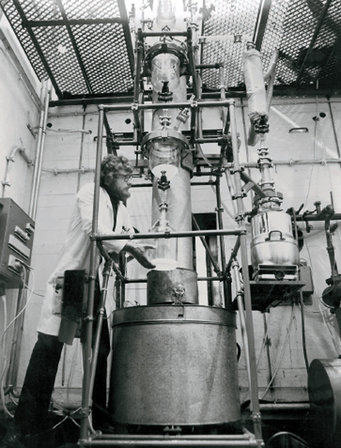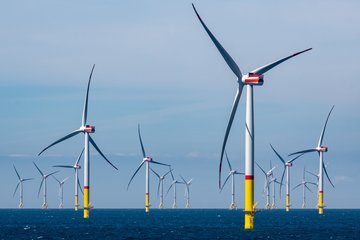Coffee withdrawal
Coffee: It leaves some people feeling fit and refreshed; in others, it makes their heart race. Scientists have developed several decaffeination processes to allow even people who react badly to caffeine to enjoy a cup of the “black brew.” Kurt Zosel from the Max Planck Institute for Coal Research in Mülheim an der Ruhr came across one of these processes quite by chance in 1967.
Text: Maren Emmerich

The average German drinks 150 liters of coffee every year, and many legends surround the history of our favorite drink. One of these is about a memorable encounter that is supposed to have occurred on October 3, 1819 in Jena. On this day, chemist Friedlieb Ferdinand Runge paid a visit to poet and privy councillor Johann Wolfgang von Goethe, who had a task for him that was of personal interest to himself.
With the words “You can use these in your experiments,” the poet handed Runge a small package of coffee beans he had received from Greece. The story goes that Goethe hoped the chemist would discover whatever it was in those coffee beans that caused his insomnia. His hopes were realized when, two years later, Runge identified caffeine.
But it was almost another century before a scientist succeeded in producing palatable decaffeinated coffee. Ludwig Roselius, a coffee merchant from Bremen, used benzene as a solvent to remove the stimulant content from the coffee beans. In 1905, Roselius patented his process and, the following year, established the company Kaffee HAG. However, in these early days, commercially available decaffeinated coffee contained traces of benzene. From a current perspective, slogans like “Always harmless! Always wholesome!” which the company used to advertise the product at that time, seem ironic at best.
The story of the discovery of a second process for removing caffeine from coffee is also inherently ironic. The method originated as a byproduct in Kurt Zosel’s laboratory at the Max Planck Institute for Coal Research. Zosel was investigating new ways of separating mixtures of substances.
Kurt Zosel, the son of a doctor, Gustav Zosel, and his wife Antonie, was born in Cologne on October 12, 1913. He obtained his high school leaving certificate in 1934 and subsequently embarked upon a degree in physics. He continued his studies in Berlin from 1937 onward. In 1939, he was drafted into the Wehrmacht (German armed forces) and wounded; he spent the end of the war in a military hospital. After the war, he moved to Aachen, where he returned to his studies, this time opting for chemistry. In 1950, Zosel obtained his degree. As a doctoral student, he joined the research group led by Karl Ziegler at the Max Planck Institute for Coal Research in Mülheim an der Ruhr; Ziegler subsequently went on to win a Nobel prize. Zosel remained at the institute after obtaining his doctorate in 1952.
He worked with supercritical carbon dioxide. Gases enter a supercritical state when they are put under very high pressure and when, simultaneously, the temperature rises above a certain threshold. Carbon dioxide becomes supercritical at 30.1 degrees Celsius and at a pressure above 73.8 bar. Supercritical carbon dioxide exhibits a range of properties, making it very popular in the chemicals industry. It may separate certain substances from a mixture of substances, while leaving others unchanged – Kurt Zosel used it for this purpose. In 1967, he noticed that caffeine was one of the substances that dissolved in supercritical carbon dioxide. Three years later, he registered his “coffee decaffeination process” for a patent.
In his patent specification, Kurt Zosel describes how the coffee beans must first be moistened in a pressure tank with steam and hot water, making the beans swell up. In a neighboring vessel, carbon dioxide is brought to a supercritical state by heating it to 70 degrees Celsius and subjecting it to 162 bars of pressure. The gas is first pumped through a water bath and then through the coffee beans. Part of the water passes to the beans and, at the same time, draws the caffeine out of the beans.
The supercritical carbon dioxide is then cooled to 25 degrees Celsius and liquefies as a result. In this state, it passes through an activated carbon filter, which captures the caffeine. In the final step, the water must be removed from the coffee beans again. This is done by channeling dry, supercritical carbon dioxide through the mixture.
Westdeutsche Allgemeine Zeitung, March 24, 1978
"This year, for the first time ever, a major German roasting house will filter the caffeine out of green coffee beans. So even those suffering from heart conditions will soon be able to enjoy the aromatic drink."
By 1970, less poisonous extraction methods, such as dichloromethane and ethyl acetate, had long since replaced the benzene from the original decaffeination method.
But even these substances can damage the body if they are taken orally. In addition, these compounds not only remove the caffeine from the coffee bean, they also remove some of the flavor, impairing the taste of the liquid end product. Moreover, it is almost impossible to remove the solvent completely from the bean mixture following the extraction process. The industry and consumers therefore gratefully accepted Zosel’s idea.
In 1978, a year before he retired, Kurt Zosel was awarded the Ruhrpreis für Kunst und Wissenschaft (Ruhr prize for art and science) by the city of Mülheim an der Ruhr. The chemist who revolutionized decaffeination died ten years later.
Today, scientists still work with supercritical carbon dioxide at the Max Planck Institute for Coal Research, which the Kaiser Wilhelm Society founded in 1912 as the first research institution to be based outside of Berlin. Nils Theyssen’s research group uses this medium to produce nanometer-sized metal particles. The re searchers then use these particles as highly efficient catalysts to accelerate chemical reactions. “We are particularly interested in converting sugars into bulk chemicals, which can then be processed in a variety of ways,” says Theyssen.
His Ph.D. supervisor, Walter Leitner, who now works at RWTH Aachen, sparked his enthusiasm for working with supercritical carbon dioxide.

"Hag" for the heart: In 1905, Ludwig Roselius patented a process for removing caffeine from coffee beans. However, the first commercially available caffeine-free drink contained traces of benzene – not exactly a healthy option!
“We can now see examples around the world of the industrial application of the extraction process that Zosel developed,” says Leitner.
For example, a Spanish company uses supercritical carbon dioxide to clean wine corks to prevent unwanted cork taint. In Korea, chemists use supercritical extraction when manufacturing soya oil.
Supercritical carbon dioxide is still used in the decaffeination of coffee today: the process is used around the world to extract caffeine from 100,000 tons of raw material every year. Kraft Foods is one of the companies using this method – the Group’s decaffeination building is located on the grounds of the former Kaffee HAG plant. The company’s product managers see two major advantages in this decaffeination process: the supercritical carbon dioxide can be removed following the extraction process without leaving any residue, and it is also a natural solvent. However, the method is relatively expensive, which is why scientists have spent years searching for coffee beans that are naturally caffeine-free.
This is a difficult undertaking, as the plants produce this substance for a reason: as a natural insecticide, caffeine keeps predators at bay. In coffee varieties that don’t produce caffeine, bitter compounds take on this role, but they also adversely affect the taste of the coffee.
The solution seemed to be within reach at the end of 2003: Brazilian Paulo Mazzafera discovered a caffeine-free coffee plant containing relatively few bitter compounds. Yet his hopes of making the seeds of this strain commercially viable have not been realized to date: the plant delivers very low yields and has so far defied all efforts to increase the yield using various breeding methods.
In other laboratories, molecular biologists struggle to use genetic engineering to switch off the instructions for caffeine production in the coffee plant. This, too, is proving a major challenge, as the plant with the reddish-brown beans steadfastly resists these types of interventions in its genome. It’s also to be expected that some consumers will boycott decaffeinated coffee made from genetically modified plants. So the future for the decaffeination process using supercritical carbon dioxide, which Kurt Zosel discovered by chance in 1967, seems to be secure, at least for a while yet.













